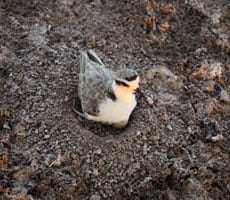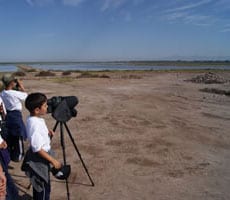by Medardo Cruz-López (1,2), Lydia Lozano-Angulo (1) and Clemens Küpper (3)
(1) Conservación, Investigación y Servicios Ambientales A.C., Matías Lazcano 2339 Dpto. A-4, Col. Tierra Blanca C.P. 80030, Culiacán, Sinaloa; (2) Maestría en Ciencias Biológicas, Centro Tlaxcala de Biología de la Conducta, Universidad Autónoma de Tlaxcala-UNAM; (3) Department of Organismic and Evolutionary Biology, Museum of Comparative Zoology, Harvard University.

Little is known about the reproductive ecology of the Snowy Plover (Charadrius nivosus) en Mexico. In 2006 a project was initiated aimed at conserving and studying the Snowy Plover in the state of Sinaloa, focusing on a wetland complex called Bahia de Ceuta, located in the old salt ponds, which had been abandoned for approximately 30 years. Our results from 2006 show the importance of this site for the reproduction of this species. A 2007 national census of Snowy Plovers revealed that Bahía de Ceuta supports approximately 8% of Mexico’s total population of this species.
During the first weeks in April each year, water deposited by tides and rains begins to evaporate and Snowy Plovers us the bottom of these salt ponds to place their nests. The chicks that hatch during the first weeks of May when water is available survive, although the majority of chicks that hatch in the last week of May and during June die due to lack of water. In 2011 the reproductive season was very short and the nesting site was covered with water until the middle of May. This year resulted in the lowest number of observations of nests and breeding birds in the last six years of the study. Nevertheless, a relatively cool spring meant that the conditions for fledglings were better, since there was also water and food available in Ceuta.
This study has demonstrated the importance of regulating water influx to the breeding zones. During six years of field work (2006-2011), our results show great variations in the number of breeding birds (93-203), nests (70-161), and fledglings (18-53). These variations seem to be associated with the amount of water available throughout the breeding season.
In addition, the results have helped clarify Snowy Plover taxonomy. For example, we demonstrated that the Snowy Plover is distinct from the Kentish Plover (Charadrius alexandrinus), which previously was thought to be the same species. Also thanks to the results of the censuses undertaken throughout Mexico in 2007, Snowy Plover now has Federal designation as “In Danger of Extinction.” This designation will help with conservation efforts for the species.
This project also included a number of different conservation actions, training workshops, and environmental education and outreach programs in local communities. We have had very good responses and acceptance from local schools, as well as community residents. Together with the Mexican National Commission for Natural Protected Areas, we have also begun formal procedures for the official protection of the Bahía de Ceuta wetlands.

